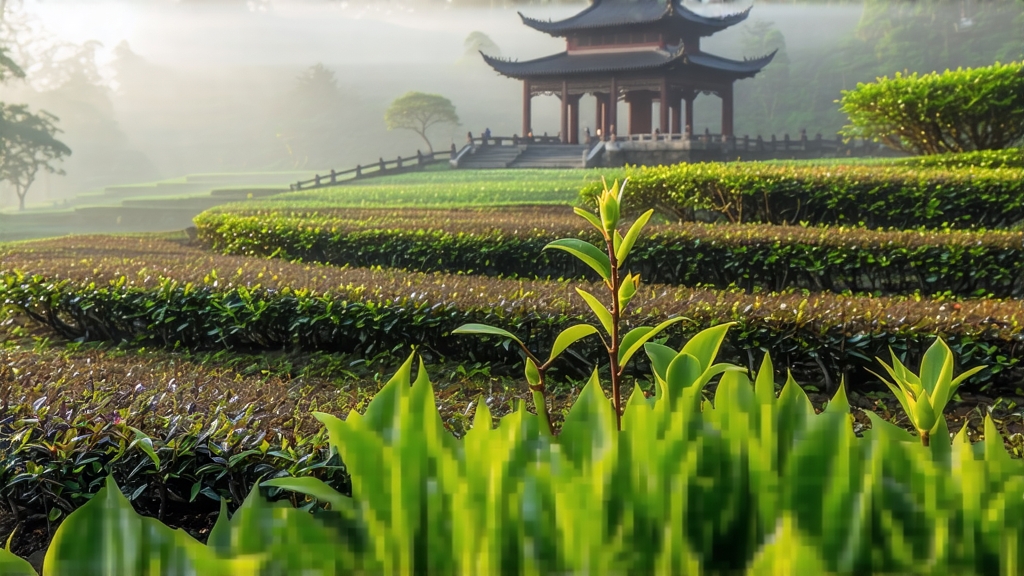
Tucked high on the northern rim of the Sichuan Basin, where the Himalayas throw their first gentle spurs toward the Yangtze, the misty spine of Meng Ding Mountain has been producing tea for more than twelve centuries. Among the cloud-borne gardens that terrace its granite flanks, one cultivar still follows a choreography so delicate that only a few hundred kilograms leave the mountain each spring: Meng Ding Huang Ya, the “Yellow Bud of Meng Ding.” To most Western drinkers yellow tea is the least familiar of China’s six great tea families; within that family Meng Ding Huang Ya is the rarest leaf most Chinese tea lovers will never taste in their lifetime. This essay invites the international reader to meet the tea that once traveled in bamboo tubes sealed with beeswax to the Tang-dynasty court, to understand why its craft was hidden behind monastery walls for generations, and to learn how a single bamboo-roasted bud can still whisper the flavor of mountain mist across a porcelain cup.
History: from monkish alchemy to imperial tribute
The first written record appears in 808 CE, when the monk Gan Zhi presented “meng ding yun ya” (cloud bud of Meng Ding) to Emperor Xianzong. By the Song dynasty the leaf had already turned yellow through a slow oxidation monks called “men huang” – sealing yellow – and the court in Kaifeng listed it among the fourteen tribute teas that arrived by fast horse. During the Ming, when compressed cakes fell from fashion, loose Meng Ding Huang Ya survived because its production was monopolized by the Buddhist Woyun Temple; monks traded it for land grants and protection. The Qing saw production peak at roughly 300 kg per year, all destined for Beijing’s Forbidden City. Revolution, war and the 1963 opening of the Meng Ding highway almost ended the craft: young workers left for factory jobs, and the subtle yellowing technique was nearly lost. A state-led restoration project in 1979 located three ageing monks who still remembered the full sequence; today seven certified families keep the tradition alive under a geographical-indication seal granted in 2007.
Terroir: why the mountain makes yellow possible
Meng Ding rises only 1 456 m, but the Sichuan cloud layer sits low; on 280 days a year the gardens are wrapped in fog that blocks direct sunlight and raises ambient humidity above 85 %. The soil is a crumbly quartz-rich granite weathered into acid loam, exceptionally porous yet water-retentive. These conditions slow photosynthesis, increasing amino acids (especially L-theanine) while keeping catechins moderate; the result is a naturally sweet, low-astringent leaf that can withstand the extra 24-hour oxidation of yellowing without turning grassy or bitter. Four micro-clonal shrubs dominate the gardens—Meng Ding #5, #9, #16 and the ancient seed-grown “Small Leaf Yellow”—all selected for downy buds and a faint natural jasmine gene that emerges during sealed oxidation.
Plucking: one bud, one leaf, one dawn
Harvest begins when the mountain azalea blooms, usually between 20 March and 5 April. Only the standard “one bud and one unfolded leaf” is taken, ideally 2.0–2.2 cm in length, still soft enough to curl into a fish-hook shape. Pickers wear cotton gloves to avoid hand-oil contamination, and every half-hour deliver bamboo baskets to the village weigh station where the fresh leaf must not exceed 1.2 kg depth to prevent bruising. A single kilogram of finished tea requires roughly 14 000 plucks, all carried out before 9 a.m. while the dew is still cool.
Craft: the lost 48 hours of “sealed yellowing”
Although yellow tea is often described as “green tea with an extra step,” the reality is a chain of micro-decisions that must be executed within a 48-hour window when ambient humidity, leaf temperature and enzymatic activity align.
-
Sha-qing (kill-green) – 180 °C for 90 seconds
Small batches of 250 g are tossed in a bamboo-roasted wok heated by local hardwood. The goal is not full de-enzyming but a 30 % reduction in polyphenol oxidase so that later yellowing proceeds slowly. -
Re-wrap rolling – 8 minutes
The hot leaf is immediately wrapped in a steamed linen cloth and rolled under 5 kg pressure, breaking 20 % of cell walls without squeezing juice; this partial